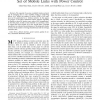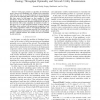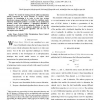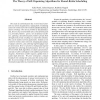535 search results - page 6 / 107 » Fractional power control for decentralized wireless networks |
TWC
2008
15 years 1 days ago
2008
The capacity of a power controlled wireless network can be changing due to user's mobility, fading or shadowing effects. As a result, the quality of service (QOS) of all users...
129
click to vote
CISS
2008
IEEE
15 years 6 months ago
2008
IEEE
— This paper presents an algorithm for distributed power control and scheduling over wireless ad hoc-networks, where the data rate on each link depends on the transmission power ...
PIMRC
2008
IEEE
15 years 6 months ago
2008
IEEE
—We extend the existing network utility maximization (NUM) framework for wired networks to wireless sensor networks by formulating it in order to take into account interference a...
SASO
2007
IEEE
15 years 6 months ago
2007
IEEE
The study of synchronization has received much attention in a variety of applications, ranging from coordinating sensors in wireless networks to models of fireflies flashing in...
PAM
2007
Springer
15 years 6 months ago
2007
Springer
Abstract. The use of power control in wireless networks can lead to two conflicting effects. An increase in the transmission power on a link may (i) improve the quality and thus t...




